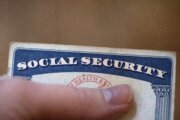When she turned 50 eight years ago, Sharan Christ of Littleton, Colorado, had a bone scan during a routine physical. Feeling perfectly healthy, she was “absolutely floored” and “devastated” to learn she had osteoporosis — the silent disease that leaves bones thin, brittle and weak.
Pat Burkey of Englewood, Florida, was a 52-year-old aquatic director when she did a back dive off the low board and felt her feet tingling as she climbed out of the pool. She didn’t realize she had three compression fractures in her back until a bone density scan at age 65 revealed osteoporosis .
Structural Threat to Your Skeleton
About 10 million Americans are estimated to have osteoporosis and 18 million more are at risk of developing the disease, according to the American Academy of Orthopaedic Surgeons. Women are at much higher risk, with 10 percent of women 50 and older affected by osteoporosis, compared with 2 percent of men that age, according to the Centers for Disease Control and Prevention. Developing osteoporosis puts people at higher risk for fractures, especially in the hips, spine and wrists. Family history, small and thin body size, anorexia, being white or Asian, rheumatoid arthritis, certain medications, sedentary lifestyle and smoking are also risk factors.
In osteoporosis, “the amount of bone is lower and the quality of the bone is weaker,” says Diane Schneider, a physician and author of “The Complete Book of Bone Health” and a former associate professor of medicine at the University of California–San Diego. But because people don’t experience any symptoms, the condition can go unsuspected for years as the bone deteriorates.
“Think about termites,” Schneider says. “What may be happening behind your walls you can’t see, in terms of the termites slowly eating away at the wood. And until there’s a structural failure and you go to do a remodel and pull off that plaster or Sheetrock, you don’t know what’s happening behind that. It’s similar to the bone.”
Osteoporosis is diagnosed with a dual-energy X-ray absorptiometry (DEXA) scan, where you lie on a table while the scanner passes over your hip and lower spine. The test produces a T-score, with scores below minus one showing increasingly worse bone health the lower they get. DEXA scans also detect osteopenia, which is early bone loss that can turn into osteoporosis.
Building Strength and Balance
When people learn they have osteoporosis, it can be scary. Realizing their bones are more fragile and likelier to break “sometimes just immobilizes people,” Schneider says. Instead of staying still, though, you should move — in a smart way — to improve strength and balance. You don’t have to change everything at once, she says, but gradually incorporate these A-to-D lifestyle changes:
A for Activity. “When I was first diagnosed, my doctor told me, ‘If you fall, you’ll probably break something,'” Christ recalls. “That scared the bejesus out of me.” But she started working out with weights with a personal trainer and doing “tons” of walking.
“What you want to do is things that ‘load’ the bone,” Schneider says, with weight-bearing exercise. However, she warns, a person with low bone density in their spine has to be careful and modify weightlifting to avoid fracture risk. She recommends a few sessions with a physical therapist to learn to exercise safely and properly.
Everyday lifting can also pose risks. For instance, you shouldn’t lean over to pick up that heavy Thanksgiving turkey out of the oven. “By doing that, if somebody has low bone density in their spine, they can actually sustain a fracture,” Schneider says. And instead of leaning over to pick up a toddler from the ground, sit down and have him or her climb into your lap.
B for Balance. Building balance is key for avoiding falls. Tai Chi and yoga are good, but Schneider says “anything to work on core strength” is helpful. You can try simple methods throughout the day, like balancing on one leg while holding onto a kitchen or bathroom counter. If you’re more advanced, you could work on stability by standing on a Bosu ball, a dome-shaped device used for balance training.
C for Calcium. Make sure you’re getting enough calcium in your diet, or if that’s not enough, through calcium supplements. Dairy products are especially rich in calcium but you can also find it in vegetables and legumes. Kale is a hot vegetable now, and Schneider says it’s “a very good source of calcium,” along with turnip greens and collards, and black and white beans.
D for Vitamin D. It’s important to stave off vitamin D deficiency in osteoporosis — it’s key for activating calcium in the body. In turn, your body needs enough sunlight for the skin to produce the vitamin. But because most people use sunscreen (as they should), and vitamin D takes about 15 to 20 minutes of daily unprotected skin exposure, most people don’t get enough sunlight, Schneider explains. She recommends taking a vitamin D supplement, particularly during the winter.
Drugs for Osteoporosis
Your doctor may talk to you about medications to slow bone loss and increase bone mass. Pills include alendronate (Fosamax), risedronate (Actonel, Atelvia) and Boniva (ibandronate, also given in IV form). Denosumab (Prolia) and teriparatide (Forteo) are given by injection. Zoledronic acid (Reclast) is given by a yearly IV infusion.
Drug therapy for osteoporosis can come with side effects, and insurance coverage varies. Ask your pharmacist about risks and benefits.
Fending Off Falls
Most falls happen inside the home, Schneider says. Reduce fall hazards by eliminating loose rugs and stray telephone cords, keeping off ladders and using night lights. When climbing stairs, have a hand free to hold onto the rail. Use grab bars and nonskid mats to make your bathroom safer.
Commonsense precautions can help you avoid outdoor falls. When the Colorado climate turns snowy and icy, Christ uses covered parking lots and holds on to a walking buddy’s arm. Meanwhile in Florida, Burkey avoids wet, slippery boardwalks at the beach.
Fracture Treatment and Follow-Up
The consequences of hip fractures can be devastating. About 1 in 5 women dies within a year of breaking a hip, and it’s actually worse for men, Schneider says, with 1 in 3 dying within a year. And in terms of quality of life, even a simple wrist fracture can have long-lasting effects for an older adult.
It’s essential to get immediate treatment for fractures and to follow up with your health care provider — whether it’s a rheumatologist, family practitioner, gerontologist or other clinician — for regular evaluation of your bone health.
Prevention and Maintenance
“Although it shows up in adulthood, osteoporosis risk begins in childhood,” Schneider says. “The important time for prevention really starts at day one, and you want your children and teens to build the strongest bones possible.” All women should have a bone density scan at age 65, or at younger ages if they have additional risk factors, according to current U.S. guidelines. Recommendations vary for men — the National Osteoporosis Foundation advises testing for men 70 and older.
If you have osteoporosis, lifestyle changes really do help, Burkey and Christ have learned. Both women have seen their bone density scores improve and they continue to stay active. “Actually, I look at this as kind of a wake-up call,” Christ says.”Because I eat better; I take better care of myself; I exercise.”
More from U.S. News
6 Fruits and Vegetables You Should Eat This Fall
5 Physical Therapy Procedures You Should Question
10 Questions Doctors Wish Their Patients Would Ask
When Your Diagnosis Is Osteoporosis originally appeared on usnews.com







